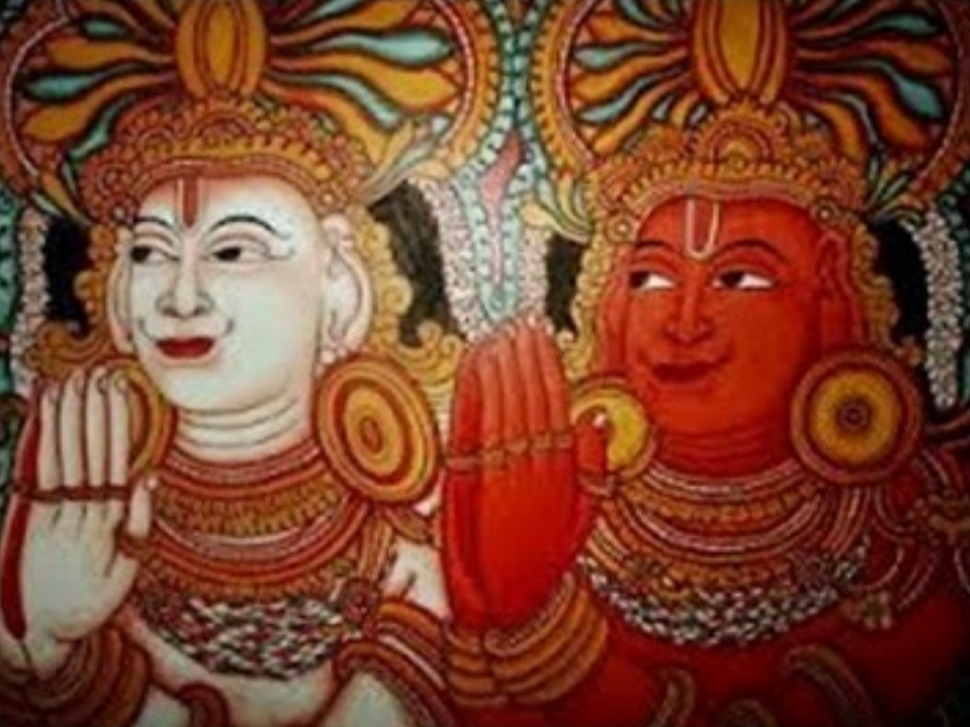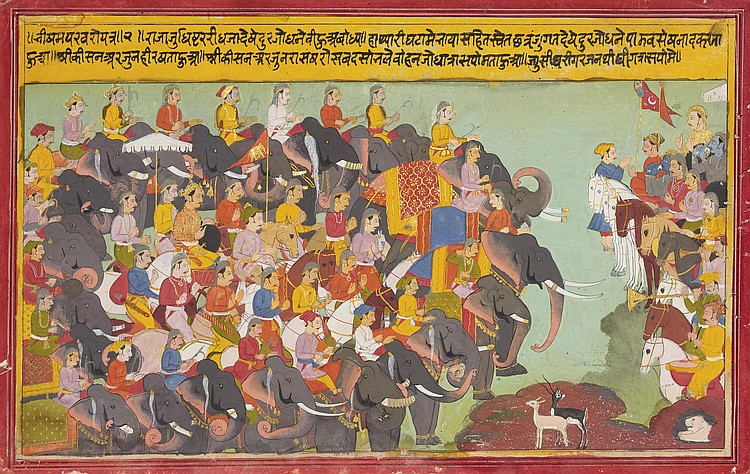|
Mādrī
Madri (, ), also known as Madravati (, ), is a character in the ''Mahabharata'', one of the two major Hindu epics. She is the princess from the Madra Kingdom and becomes the second wife of Pandu, the king of the Kuru Kingdom. She is the mother of the twins Nakula and Sahadeva, the youngest of the five Pandava brothers. Madri is the daughter of Madraraja—the king of Madra—and sister of Shalya. Her marriage to Pandu is arranged by Bhishma, the grandsire of the Kuru dynasty, in exchange for a heavy bride price. Pandu is cursed that he would die if he engaged in sexual relations. Following the curse, Madri accompanies Pandu in his self-imposed exile, along with Pandu's first wife, Kunti. Using Kunti's divine boon, Madri invokes the twin gods Ashvins to conceive her twin sons. Later, the cursed Pandu dies when he is overcome by desire and attempts to engage in lovemaking with Madri. Overcome with remorse and grief, Madri entrusts her sons to Kunti's care and joins him in deat ... [...More Info...] [...Related Items...] OR: [Wikipedia] [Google] [Baidu] |
Nakula
Nakula () is a major character in the ancient Indian epic, the ''Mahabharata.'' He is the elder twin brother of Sahadeva and the fourth of the five Pandava brothers. He is the son of Divine twins, twin physician gods, Ashvins, and Madri, the second wife of King Pandu of Kuru kingdom, Kuru dynasty. In the epic, Nakula is described as the most handsome man of his lineage, and was renowned for his skill in swordsmanship and horse keeping. He was married to Draupadi, as were his four brothers. He was also married to Karenumati of Chedi Kingdom. He had two sons Shatanika and Niramitra from his two wives respectively. During the Rajasuya of his eldest brother Yudhishthira, he conquered the kings of the Sivis, the Rohitakas and other dynasties. After Yudhishthira lost all his possessions to his cousin Duryodhana in a dice game, the Pandavas and Draupadi were exiled for thirteen years. During the Pandavas' year of incognito exile, he disguised as a horse trainer named Granthika, and w ... [...More Info...] [...Related Items...] OR: [Wikipedia] [Google] [Baidu] |
Madra Kingdom
Madra kingdom (; ) was a kingdom grouped among the western kingdoms in the Indian epic poetry, ancient Indian epic ''Mahabharata''. Its capital was Sagala in the Madra region. The Kuru (kingdom), Kuru king Pandu's (''Pāṇḍu'') second wife was from Madra kingdom and was called Madri (; ; Help:IPA/Sanskrit, IPA/Sanskrit: ). The Pandava twins, Nakula and Sahadeva, were her sons. Madri's brother Shalya was the king of Madra. Though affectionate to the Pandavas, he was tricked to give support to Duryodhana and fought against the Pandavas during the Kurukshetra War. He was killed by Yudhishthira, the eldest Pandava. Other than the Madra kingdom (Eastern Madra or Purva Madra) with Sagala as its capital, it is believed that there was a Western Madra (Apara Madra) and a Northern Madra (Uttara Madra). Origin According to the Vayu Purana, the Madra kingdom was founded by King Ushinara Shibi of the Anu race. Anu was the son of Yayati. According to Bhagavata Purana, The kingdom of Mad ... [...More Info...] [...Related Items...] OR: [Wikipedia] [Google] [Baidu] |
Sahadeva
Sahadeva () was the youngest of the five Pandava brothers in the ancient Indian epic, the '' Mahabharata''. He and his twin brother Nakula were the sons of Madri, one of the wives of the Pandava patriarch Pandu, and Ashvini Kumaras, the divine twin physicians of the gods, whom she invoked to beget her sons due to Pandu's inability to progenate. Sahadeva is renowned for his wisdom, knowledge of astrology, and skill in swordsmanship. Sahadeva was married to Draupadi, as were his four brothers. He was also married to Vijaya of Madra kingdom. He had two sons, Shrutasena and Suhotra, from his two wives respectively. Sahadeva played a crucial role during the Rajasuya of Yudhishthira, where he conquered the kings of the South. After Yudhishthira lost all of his possessions to Duryodhana in the game of dice, Sahadeva vowed to slay Shakuni, Duryodhana's maternal uncle, who had used loaded dice to unfairly win the game. Afterwards, the Pandavas and Draupadi were exiled for thi ... [...More Info...] [...Related Items...] OR: [Wikipedia] [Google] [Baidu] |
Mahabharata
The ''Mahābhārata'' ( ; , , ) is one of the two major Sanskrit Indian epic poetry, epics of ancient India revered as Smriti texts in Hinduism, the other being the ''Ramayana, Rāmāyaṇa''. It narrates the events and aftermath of the Kurukshetra War, a war of succession between two groups of princely cousins, the Kauravas and the Pandava, Pāṇḍavas. It also contains Hindu philosophy, philosophical and devotional material, such as a discussion of the four "goals of life" or ''puruṣārtha'' (12.161). Among the principal works and stories in the ''Mahābhārata'' are the ''Bhagavad Gita'', the story of Damayanti, the story of Shakuntala, the story of Pururava and Urvashi, the story of Savitri and Satyavan, the story of Kacha (sage), Kacha and Devayani, the story of Rishyasringa and an Ramopakhyana, abbreviated version of the ''Rāmāyaṇa'', often considered as works in their own right. Traditionally, the authorship of the ''Mahābhārata'' is attributed to Vyasa, Vy ... [...More Info...] [...Related Items...] OR: [Wikipedia] [Google] [Baidu] |
Vishnu Sitaram Sukthankar
Vishnu Sitaram Sukthankar, also known as V. S. Sukthankar (4 May 1887 – 21 January 1943), was an Indologist and scholar of Sanskrit. He is principally known as the General Editor of the Critical Edition of the Mahabharata published by the Bhandarkar Oriental Research Institute in Pune, India. Early life Vishnu Sitaram Sukthankar was born on 4 May 1887 to Sitaram Sukthankar, his father, a civil engineer, and Dhaklibai, his mother. He married Eleanor Bowing (1889–1927) on 29 July 1908. Together they had children named John (1908), Kathleen (1912) and Maurice (1913), and Lalnath (1923). Education Sukthankar was educated at the Maratha High School and later at St. Xavier's College in Bombay. After passing his Intermediate Examination, he left for England and studied mathematics during the years 1903–1906 at St. John's College, Cambridge and passing his Mathematical Tripos. In 1909, he studied at the University of Edinburgh. Meanwhile, his interests had turned to Indology. ... [...More Info...] [...Related Items...] OR: [Wikipedia] [Google] [Baidu] |
Kaurava
''Kaurava'' is a Sanskrit term which refers to descendants of Kuru, a legendary king of India who is the ancestor of many of the characters of the epic ''Mahabharata''. Usually, the term is used for the 100 sons of King Dhritarashtra and his wife Gandhari. Duryodhana, Dushasana, Vikarna and Chitrasena are the most popular among the brothers. They also had a sister named Dussala and a half-brother named Yuyutsu. Etymology The term ''Kauravas'' is used in the ''Mahabharata'' with two meanings , *The wider meaning is used to represent all the descendants of Kuru. This meaning, which includes the Pandava brothers, is often used in the earlier parts of popular renditions of the ''Mahabharata''. *The narrower but more common meaning is used to represent the elder line of the descendants of Kuru. This restricts it to the children of King Dhritarashtra, excluding the children of his younger brother, Pandu, whose children form the Pandava line. The rest of this article deals ... [...More Info...] [...Related Items...] OR: [Wikipedia] [Google] [Baidu] |
Classical Sanskrit
Sanskrit (; stem form ; nominal singular , ,) is a classical language belonging to the Indo-Aryan branch of the Indo-European languages. It arose in northwest South Asia after its predecessor languages had diffused there from the northwest in the late Bronze Age. Sanskrit is the sacred language of Hinduism, the language of classical Hindu philosophy, and of historical texts of Buddhism and Jainism. It was a link language in ancient and medieval South Asia, and upon transmission of Hindu and Buddhist culture to Southeast Asia, East Asia and Central Asia in the early medieval era, it became a language of religion and high culture, and of the political elites in some of these regions. As a result, Sanskrit had a lasting effect on the languages of South Asia, Southeast Asia and East Asia, especially in their formal and learned vocabularies. Sanskrit generally connotes several Old Indo-Aryan language varieties. The most archaic of these is the Vedic Sanskrit found in the Rig ... [...More Info...] [...Related Items...] OR: [Wikipedia] [Google] [Baidu] |
Bhagavad Gita
The Bhagavad Gita (; ), often referred to as the Gita (), is a Hindu texts, Hindu scripture, dated to the second or first century BCE, which forms part of the Hindu epic, epic poem Mahabharata. The Gita is a synthesis of various strands of Indian religious thought, including the Vedic concept of ''dharma'' (duty, rightful action); samkhya-based ''yoga'' and ''jnana'' (knowledge); and ''bhakti'' (devotion). Among the Hindu denominations, Hindu traditions, the text holds a unique pan-Hindu influence as the most prominent sacred text and is a central text in Vedanta and the Vaishnava, Vaishnava Hindu tradition. While traditionally attributed to the sage Veda Vyasa, the Gita is historiographically regarded as a composite work by multiple authors. Incorporating teachings from the Upanishads and the samkhya Yoga (philosophy), yoga philosophy, the Gita is set in a narrative framework of dialogue between the pandava prince Arjuna and his charioteer guide Krishna, an avatar of Vishnu, a ... [...More Info...] [...Related Items...] OR: [Wikipedia] [Google] [Baidu] |
Critical Edition
Textual criticism is a branch of textual scholarship, philology, and literary criticism that is concerned with the identification of textual variants, or different versions, of either manuscripts (mss) or of printed books. Such texts may range in dates from the earliest writing in cuneiform, impressed on clay, for example, to multiple unpublished versions of a 21st-century author's work. Historically, scribes who were paid to copy documents may have been literate, but many were simply copyists, mimicking the shapes of letters without necessarily understanding what they meant. This means that unintentional alterations were common when copying manuscripts by hand. Intentional alterations may have been made as well, for example, the censoring of printed work for political, religious or cultural reasons. The objective of the textual critic's work is to provide a better understanding of the creation and historical transmission of the text and its variants. This understanding may lead ... [...More Info...] [...Related Items...] OR: [Wikipedia] [Google] [Baidu] |








